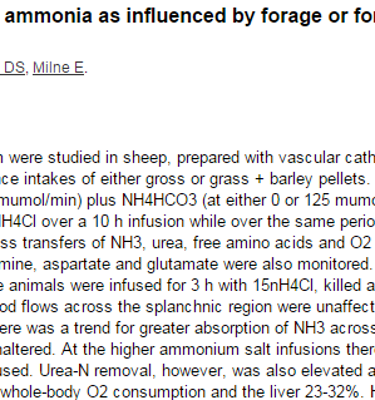The fate of absorbed and exogenous ammonia as influenced by forage or forage-concentrate diets in growing sheep
Abstract: Changes in splanchnic energy and N metabolism were studied in sheep, prepared with vascular catheters across the portal-drained viscera (PDV) and the liver, and maintained on supramaintenance intakes of either gross or grass + barley pellets.
The animals were challenged, on both diets, with 4 d intramesenteric vein infusions of NH4Cl (25 mumol/min) plus NH4HCO3 (at either 0 or 125 mumol/min). On the final day of each treatment the natural abundance NH4Cl was replaced with 15NH4Cl over a 10 h infusion while over the same period [1-13C]leucine was infused via a jugular vein. Measurements were made of blood flow plus mass transfers of NH3, urea, free amino acids and O2 across the PDV and liver. Enrichments of [14N15N]urea and [15N15N]urea plus [15N]glutamine, aspartate and glutamate were also monitored. Whole-body urea flux was determined by infusion of [14C]urea. At the end of the study the animals were infused for 3 h with 15nH4Cl, killed and liver samples assayed for intracellular free amino acid enrichments and concentrations. Blood flows across the splanchnic region were unaffected by either diet or level of ammonium salt infusion. At the lower ammonium salt infusion there was a trend for greater absorption of NH3 across the PDV (P < 0.10) with grass + barley than with the grass diet, while removal of urea was unaltered. At the higher ammonium salt infusions there was a significantly greater appearance of NH3 across the PDV and this exceeded the extra infused. Urea-N removal, however, was also elevated and by more than that required to account for the additional NH3. The PDV contributed 19-28% to whole-body O2 consumption and the liver 23-32%. Hepatic extraction of absorbed NH3 was complete on all treatments and systemic pH remained constant. The fractions of urea-N apparently derived from NH3 were similar on the grass (0.50-0.64) and grass + barley (0.64-0.67) diets. Hepatic production of urea agreed well with urea flux measurements. Between the two levels of ammonium salt infusion and within diets the additional NH3 removed across the PDV was accounted for by the increased urea-N production. The [14N15N]:[15N15N] ratio of the urea produced was 97:3, while the enrichment of hepatic intracellular free aspartate was lower than that of [14N15N]urea. Glutamine enrichments were 0.23-0.37 those of [14N15N]urea, indicating a minor role for those hepatocytes (probably perivenous) which contain glutamine synthetase (EC 6.3.1.2). Leucine kinetics, either for the whole body or splanchnic tissues, were not different between diets or level of ammonium salt infusion, except for oxidation which was less on the grass + barley ration. Amino acid concentrations were lower on the grass + barley diet but net PDV absorptions were similar. The pattern of essential amino acids absorbed into the PDV showed good agreement with the published composition of mixed rumen microbial protein. Fractional disappearances of absorbed free essential amino acids across the liver varied from 0.4 (branched chains) to near unity (histidine, phenylalanine).
Referentie
Lobley, G. E., Weijs, P. J. M., Connell, A., Calder, A. G., Brown, D. S., Milne, E. 'The fate of absorbed and exogenous ammonia as influenced by forage or forage-concentrate diets in growing sheep'. In: Br J Nutr. 1996 Aug;76(2):231-48.

